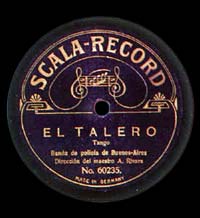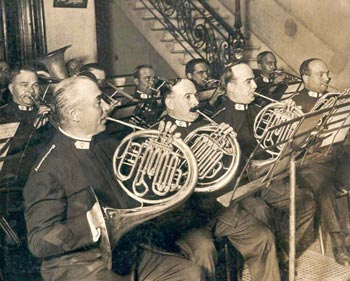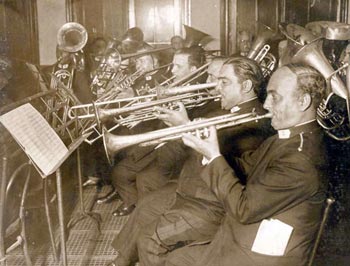By
Bands, rondallas and tangos

he early recordings of tangos by an Orquesta Típica (tango orchestra) were made in the early 1910. This honor belonged to the one fronted by the bandoneonist Vicente Greco. But before this milestone, and coexisting (even though scarcely) until 1914 with the tango orchestras, a large number of recordings of this genre were made by other kinds of aggregations, especially bands and rondallas.
The former are similar to the present ones and are comprised of wind instruments and may also have snare drum, bass drum and cymbals to stress the rhythmical aspect. As it would be expected, most them belonged to military or municipal institutions.

As for the rondallas, we can say that according to the discs published until around 1910, they were formed similarly to their Spanish counterparts. Because of that, guitars, bandurrias, lutes and mandolins were predominant, with the occasional inclusion of some violin or flute. After that year its line-up became somewhat eclectic, involving the most varied timbre combinations. The term “rondalla”is used to generally indicate a small group, with sweet sound, not martial, different to the bands.
It is interesting to explain that in our milieu recordings made by bands or by rondallas cut either in our country or abroad were released. Tango records recorded abroad by labels with agents in our country were also sold in the European, North American and probably South American market. And in order to write the arrangements and the orchestrations, the sheet music copies were sent abroad. As for the year, we can verify this kind of cultural invasion prior to what was usually thought.
 Let us mention now some examples of the recording activity of those aggregations. Let us begin with the bands. The first in recording tangos was the Royal Military Band of London. They were European Gramophone and/or Victor discs for the Americas in the mid-1905, originally with only one side. We can mention the tangos “Guido-La payada” by José Luis Roncallo (matrix 2.052 e, Victor disc 62.146-A) and “¡Ay, chinita!” by unknown author (matrix 2.084 e, Victor disc 62.151-A). It is a group with a polished performance.
Let us mention now some examples of the recording activity of those aggregations. Let us begin with the bands. The first in recording tangos was the Royal Military Band of London. They were European Gramophone and/or Victor discs for the Americas in the mid-1905, originally with only one side. We can mention the tangos “Guido-La payada” by José Luis Roncallo (matrix 2.052 e, Victor disc 62.146-A) and “¡Ay, chinita!” by unknown author (matrix 2.084 e, Victor disc 62.151-A). It is a group with a polished performance.
In 1906 we have eight tangos recorded in USA by the prestigious Sousa Band. For example, “Recuerdos de la pampa” by Alfredo Bevilacqua (Victor disc 62.157-A, “El malevo” by Joaquín Cortés López (Victor disc 62.152-A) and “El afilador” by Leopoldo Corretjer (Victor disc 62.609-B). These recordings are quite excellent.
That same year, Columbia released a vast series of recordings, also made abroad, by the so called Banda Española, in matrix series 5.500 and 6.000. The performances evidence that the name of the band was generic because the line-up of the instrumentalists is changeable like the style of the arrangements. Among around fifty tangos, we can mention “¡Te pasaste!” by José Luis Roncallo (matrix 5.547-2, disc C 9), “Don José María” by Rosendo Mendizábal (matrix 6.010, disc T 89) or “¡Vas a vivir mucho!” by Ángel Villoldo (matrix 6.019-2, disc T 93).

Coming back to our country, in 1907 for the Odeon label (brown label) a Banda de Buenos Aires appeared which recorded over twenty tango pieces, “¡No crea, rubio!” by José Luis Roncallo (matrix BA 298, side 11.259), “Firulete” by Dafne Zenón Rolón (matrix BA 380, side 11.283) and “¡Aflojá un peso, ché!” by Antonio Lagomarsino (matrix BA 452, side 11.301).
Around 1908 from France a series of nearly sixty tangos played by the Paris Republican Guard Band arrived, Gath & Chaves label. Impeccable recording quality, arrangements and performance. From the near sixty recorded tangos, we mention “La budinera”by Villoldo (matrix 215), “El sargento Cabral” by Manuel Campoamor (matrix 219) or “Joaquina” by Juan Bergamino (matrix 229).
In 1910 local recordings were made by the Banda de Policía led by A. Rivara, for the Columbia and ERA labels. The tango pieces meant around a hundred recordings, from which we can highlight “El incendio” by Arturo De Bassi (matrix 55.439, Columbia disc T 235), “Pura parada” by María Teresa Viero (matrix 60.350, ERA label) and “¡Echale Bufach al catre!” by José Manuel Tagle (matrix 60.367, ERA label). The performing quality was not the best.
 Also that year there were Victor discs by the Banda del Pabellónde las Rosas, with eight tangos played adequately. For example, “El franchuto” by César Sesso who was his leader (disc 62.769-A), “¡Tocalo más fuerte!” by Pancho Nicolín (disc 62.921-B) and “El polo” by Ramón Coll (disc 62.781-B). This aggregation will record more tango pieces in 1912.
Also that year there were Victor discs by the Banda del Pabellónde las Rosas, with eight tangos played adequately. For example, “El franchuto” by César Sesso who was his leader (disc 62.769-A), “¡Tocalo más fuerte!” by Pancho Nicolín (disc 62.921-B) and “El polo” by Ramón Coll (disc 62.781-B). This aggregation will record more tango pieces in 1912.
In the late 1910 we mention the recordings for Odeon (blue label), side serie A 85.000 by the Banda Italo Argentina, led either by Arturo De Bassi or maestro Lozzi. Despite noticeable problems of intonation they cut almost forty tango pìeces. Among them, “Mordele la cola al chancho” by Arturo De Bassi (matrix Bg 50, side A 85.048), “Don Eduardo” by Luis B. Chiappe Ducca (matrix Bg 39, side A 85.037) or “La berlina de los novios” by Rosendo Mendizábal (matrix Bg 169, side A 85.186).
In 1911 the Banda Municipal began its impeccable recordings for Columbia of around seventy tangos tunes, with quite good arrangements. For example, “¡Prendete del brazo, nena!” by Villoldo (matrix 55.681, disc T 374), “Qué hubo de haber habido” by Arturo De Bassi (matrix 55.722, disc T 389) or “El irresistible” by Lorenzo Logatti (matrix 55.945, disc T 491).

In 1912 the Banda del 1º de Infantería recorded four tangos for Columbia. They were “El milico” (matrix 56.663, disc T 581), “Te gusta el mate” (matrix 56.662, disc T 548) and “Buena noche” (matrix 56.664, disc T 549) written by its leader Francisco Pinto, and “Te felicito, ché” by Signorelli and Menfi (matrix 56.665, disc T 549). We inform you that this band had previously recorded a handful of tangos in 1910.
Almost at the end of this revision, we say that the recordings by the Banda Atlanta, in the label with the same name, whose leader was Arturo De Bassi were also made in 1912. We shall mention “Echale carbón al horno” by Hugo Patalano (unknown matrix, side 65.294), “¿Indio? ¡sacale el pelo!” by Roberto Firpo (unknown matrix, side 65.274) and “All’olio” by Juan Mallada (matrix 185, side 65.260).
A last example would be the Banda del Parque Japonés conducted by Gaetano D’Alo, which recorded in 1914 for Columbia the tango “El apache argentino” by Manuel Aróztegui (matrix 59.019, disc T 805).
In a next note we shall mention the recordings made by the rondallas.
Photos of the bands, from de site:
http://www.bandasinfonica.com.ar/imagenes_html/antiguas.htm